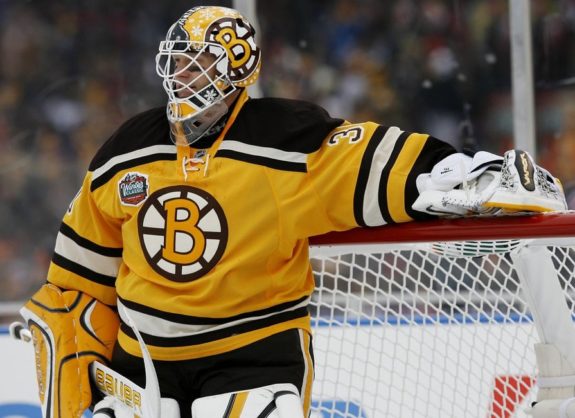It wasn’t the result that the Canadians hoped for, but for Matt Tomkins, the 2022 Beijing Olympics could not have gone better. Initially slotted as the team’s backup, he made his first start against China after starter Eddie Pasquale’s rough game against the United States and posted a shutout in his debut in what turned out to be a surprisingly competitive game. That performance earned him the next two starts, and although Canada eventually fell to Sweden in the quarter-finals, Tomkins was easily one of the best performers.

The last time the NHL skipped the Olympics, several players ended up with NHL contracts based on their performances at the Games. Dominik Kahun, a big part of Germany’s 2018 silver medal win, signed with the Chicago Blackhawks, while Ilya Kovalchuk returned to the league via the Los Angeles Kings thanks to his dominance with the Russian Olympic Committee (ROC). Nikita Gusev, Pavel Francouz, Mikko Koskinen, and Pius Suter can also thank their Olympic efforts in 2018 for their professional contracts. Although all of them thrived in their respective European leagues, the Olympics provided a much larger stage for them to capture the interest of NHL teams looking to find that next hidden gem.
This year will be no different. Several players have certainly earned an offer from an NHL team, from the gold-medalist Finns to the surprising Chinese. But from the Canadians, Tomkins should be getting the most interest, as he proved that he can handle the big pressures of being a starting goaltender in the NHL.
Dominance at the Olympics
Although Pasquale was set to be Canada’s starter, after two games, he was looking a bit shaky. He stopped all but one of Germany’s 24 shots in their tournament opener but allowed four against the Americans. With several capable goalies on their roster, Canada decided to give Tomkins a shot against China in Game 3; the International Ice Hockey Federation’s (IIHF) 32nd-ranked teams should give the first-ranked Canadians any trouble at all, and thus would give Pasquale a rest. But China proved to be much more challenging than first expected, peppering Tomkins with 26 shots, several of which were odd-man rushes and high-danger chances. However, Canada’s goalie stood tall, turning away every chance to secure the win.
With the team set to face China again in the first round of the playoffs, Tomkins once again was given the nod to start over Pasquale. China came out even stronger this time, eager to earn their first win in Olympic history, but Tomkins was remarkably consistent between the pipes despite the team in front of him struggling throughout the game, stopping 27 of China’s 29 shots and holding on for the 7-2 victory.
That win secured Canada’s spot in the quarterfinals and they were set to face arguably their most challenging opponent to date — Sweden. Built similarly to the Canadians in that they relied on experience and grit over youth, Sweden would test the Canadians more so than any other team in the tournament, and the matchup was going to be a 60-minute slog. Canada needed their best goalie in the net, and they chose none other than Tomkins, a huge statement on their faith in his skill and reliability. Once again, he was remarkably solid, allowing just two goals on 26 shots, but the rest of the team was unable to overcome the Swedes and Canada fell 2-0.
Related: Canada’s Tambellini Has Tools to Be Team’s Top Scorer
When the tournament was all said and done, Tomkins had a 1.01 goals-against average (GAA) and a 0.963 save percentage (SV%). Only one goalie who started the majority of his team’s games had a better record, that being Slovakia’s Patrik Rybar, who was named the Games’ top goaltender. Tomkins also tied with Switzerland’s Leonardo Genoni for the least goals allowed among starting goalies with just three. It’s fair to say, then, that only two goalies were more consistent than Tomkins at the 2022 Beijing Olympics. That’s an impressive feat no matter the tournament.
Tomkin’s Prior AHL and SHL Experience
Tomkin’s success didn’t come out of thin air; he’s been one of the Swedish Hockey League’s (SHL) best goalies this season, too, posting a 0.913 SV%, a 2.32 GAA, and two shutouts with Frölunda HC. His numbers are remarkably similar to Minnesota Wild prospect and former first-round draft pick Jesper Wallstedt, who has helped Luleå HF climb to third in the league; Frölunda sits just a point behind them in fourth. However, it was Tomkins and Frölunda who were invited to the Champions Hockey League tournament, where the team climbed to the semifinals before being eliminated by fellow SHL team Rögle BK. Yet, much like against Sweden in the Olympics, Tomkins was the team’s best player despite the loss.
Maybe the biggest surprise, however, is that this is just Tomkin’s first season in the SHL. Before his arrival, he played in the Chicago Blackhawks system for four seasons dating back to 2017-18 when he inked his entry-level contract with the franchise. He was a late-round draft pick in 2012 after some middling seasons with his hometown Sherwood Park Crusaders of the Alberta Junior Hockey League. He also wasn’t spectacular in college, either, posting a 3.03 GAA and a 0.898 SV% career record with Ohio State. But the Blackhawks still decided he was worth the risk and signed him after he graduated, sending him to the American Hockey League’s (AHL) Rockford IceHogs.
It was more of the same in the AHL for Tomkins, who rarely recorded an SV% higher than 0.905 and spent half the time down in the ECHL for his first two professional seasons. Still, he was a strong performer with the Indy Fuel, ranking first among ECHL goalies in minutes, tied for wins, and second in saves, and it was good enough for a two-year, two-way extension. He spent the next two seasons solely in the AHL but was stuck as the third-string goalie behind Kevin Lankinen and Collin Delia, where he played just 28 games and possessed a losing record.

It must have been frustrating for Tomkins to be stuck in that situation, unable to secure a spot in the NHL while also unable to get enough time in the minors, but it all changed when he was selected to Team Canada for the 2019 Spengler Cup. Although he just played once, he allowed just a single goal in 34 shots against HC Davos. It was that performance that opened up the opportunity for him to play in Europe, and after his contract expired in 2020-21, he signed a one-year deal to play in Sweden.
Goaltenders Find Success Later
It’s not all that surprising that Tomkins, at 27 years old, is just now finding success after fizzling out in North America. Goaltenders often take much longer to develop than forwards or defencemen, and several netminders have finally found their rhythm later in their careers. The best modern example is Tim Thomas, who made his NHL debut with the Boston Bruins in 2002-03, nine years after he was selected by the Quebec Nordiques in the ninth round of the 1994 Draft. It took him another three seasons before he was the team’s starter, and by then, he was 32 years old. Three seasons after that, he was a Vezina winner as the league’s best goalie, and two seasons after that, he was a Stanley Cup Champion and the oldest Conn Smythe Trophy recipient.

Thomas is far from the only one to find success much later in their hockey careers. Francouz and Koskinen both arrived in the NHL in their late 20s, turning their Olympic success into NHL contracts, and found immediate success with their respective teams. Even Toronto Maple Leafs’ starter Jack Campbell took some time before he realized his potential; he was 29 when he was given the job. This season, 27-year-old Ville Husso has been the latest goaltender to come out of nowhere and claim a starting role with the St. Louis Blues after a long career in Finland and the AHL.
In comparison, Tomkins is far from an outlier should he make his NHL debut next season. He’s relatively young in goalie terms and his latest performances have proven that he can handle high-pressure environments, both in Europe and internationally. He’s done everything he can to prove that he is worthy of a shot at an NHL job, and thanks to his expiring contract, plenty of teams should be looking at signing one of Canada’s Olympic stars.
